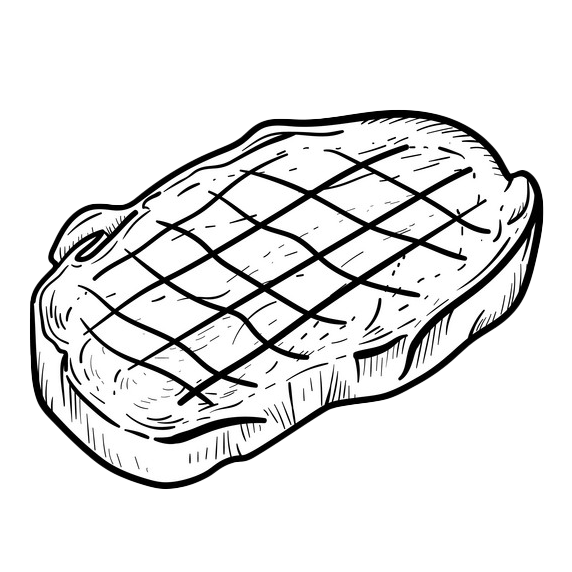Grass Fed Beef vs Grain Fed Beef
Dale Mayo, February 10, 2022
Is Grass Fed Beef Really Healthier Than Grain Fed Beef?
We’ve known for more than a decade that grass fed beef has less fat and more nutrients than less expensive grain-fed beef and that grass fed beef has lower total saturated and mono-unsaturated fat. In addition, grass fed beef has more heart healthy omega-3 fatty acids, a lower (and healthier) ratio of omega-6 to omega-3 fatty acids, and higher levels of vitamin E, beta-carotene and B-vitamins.[1] While oily fish is the richest dietary source of omega-3 fatty acids, red meat produced from grass-fed animals is also recognized as a source of omega-3s[2] and appears to provide about 50% more omega-3s than conventional grain fed beef.[3]
What is NOT found in grass fed organic beef may be as important as the nutrition it provides. Animals from factory farms are more prone to diseases spread from feed pumped with antibiotics.[4] According to Consumer Reports, in a study of 300 meat samples from conventional and grass fed beef, superbugs were found in 18% of conventional beef samples and only 6% of grass fed samples.
What’s the Difference Between Grain Fed and Grass Fed?
Where beef is mass-produced, cattle are usually fed grain, whereas grass fed cows eat (mostly) grass. Grass fed beef contains less fat than grain fed beef (therefore fewer calories).[5] According to a 2019 healthline article, the fatty acids are also different:
- Monounsaturated fat. Grass-fed beef contains much less monounsaturated fat than grain-fed beef.[6]
- Omega-6 polyunsaturated fats. Grass- and grain-fed beef contain very similar amounts of omega-6 fatty acids.
- Omega-3s. This is where grass-fed makes a major difference, containing up to five times as much omega-3.[7]
- Conjugated linoleic acid (CLA). Grass-fed beef contains about twice as much CLA as grain-fed beef. This fatty acid is associated with a few health benefits.[8], [9]
Grass fed beef that is also organic, provides nutritional benefits as well as omitting hormones and antibiotics. To be labeled organic meat by the US Department of Agriculture, regulations require that animals are raised in living conditions accommodating their natural behaviors (like the ability to graze on pasture), fed 100% organic feed and forage, and not administered antibiotics or hormones.[10] According to a
The Cleveland Clinic provides a list of benefits of eating organic foods[11] (see below).
Benefits of Eating Organic Foods
- Reduced exposure to pesticides and insecticides. This is a significant benefit of organic produce and grains.
- Increased exposure to omega-3 fatty acids. Livestock fed through grazing usually have higher levels of omega-3 fatty acids, which provide healthy heart benefits.
- Less exposure to cadmium. Studies have shown significantly lower levels of the toxic metal cadmium in organic grains.
- Increased levels of vitamins, minerals, antioxidants and other beneficial micronutrients. Organically grown fruits, vegetables and grains have higher amounts of vitamin C, vitamin E and carotenoids; plus higher amounts of the minerals calcium, potassium, phosphorus, magnesium and iron.
- Less bacteria. Less exposure to bacteria in meat.
- Less exposure to antibiotics. Eating organic meats leads to less exposure to antibiotics and growth hormones that have been used to treat livestock. These medicines may lead to antibiotic resistance and other problems in humans.
Grass Fed Beef is a Natural Fit for Keto and Paleo Diets
Protein helps you feel full when you’re following a Keto, Paleo, or Whole30 lifestyle, so it’s important to choose the healthiest proteins available.
Grass fed beef provides lean protein, rich taste, and a path from farm to table that you can feel good about. Plus, both the Keto and Paleo diets recommend grass fed beef over grain or corn fed beef, so it’s important to find selections that work for you. Adding these cuts of grass fed beef to your menu and keeping an eye on our website for more recipe ideas, trends, and cooking tips can help you get started.[12]
For healthy proteins loaded with omega-3 fatty acids, Sizzlefish has added 100% natural grass-fed, hormone-free steaks, and ground beef to its omega-3-rich fish options already carried by sizzlefish (salmon, cod, trout, seafood collections).
References
[1] https://www.ewg.org/meateatersguide/a-meat-eaters-guide-to-climate-change-health-what-you-eat-matters/why-go-organic-grass-fed-and-pasture-raised/
[2] McAfee, A., McSorley, E., Cuskelly, G., Fearon, A., Moss, B., Beattie, J., Wallace, J.M.W., Bonham, M.P., and Strain, J. (2011). Red meat from animals offered a grass diet increases plasma and platelet n-3 PUFA in healthy consumers. British Journal of Nutrition, 105(1), 80-89. doi:10.1017/S0007114510003090
[3] https://www.detroitnews.com/story/life/advice/2021/06/10/dr-roach-grass-fed-beef-best-source-omega-fatty-acid/116925656/
[4] https://health.clevelandclinic.org/grass-fed-vs-organic-meat-whats-the-difference/
[5] https://pubmed.ncbi.nlm.nih.gov/24018274/
[6] https://pubmed.ncbi.nlm.nih.gov/24018274/
[7] McAfee, A., McSorley, E., Cuskelly, G., Fearon, A., Moss, B., Beattie, J., Wallace, J.M.W., Bonham, M.P., and Strain, J. (2011). Red meat from animals offered a grass diet increases plasma and platelet n-3 PUFA in healthy consumers. British Journal of Nutrition, 105(1), 80-89. doi:10.1017/S0007114510003090
[8] https://pubmed.ncbi.nlm.nih.gov/22062051/
[9] https://pubmed.ncbi.nlm.nih.gov/17490954/
[10] https://www.usda.gov/media/blog/2012/03/22/organic-101-what-usda-organic-label-means
[11] https://my.clevelandclinic.org/health/articles/17668-organic-foods
[12] https://grassrunfarms.com/blog/why-grass-fed-beef-is-ideal-for-your-keto-paleo-or-whole30-diet/








Leave a comment